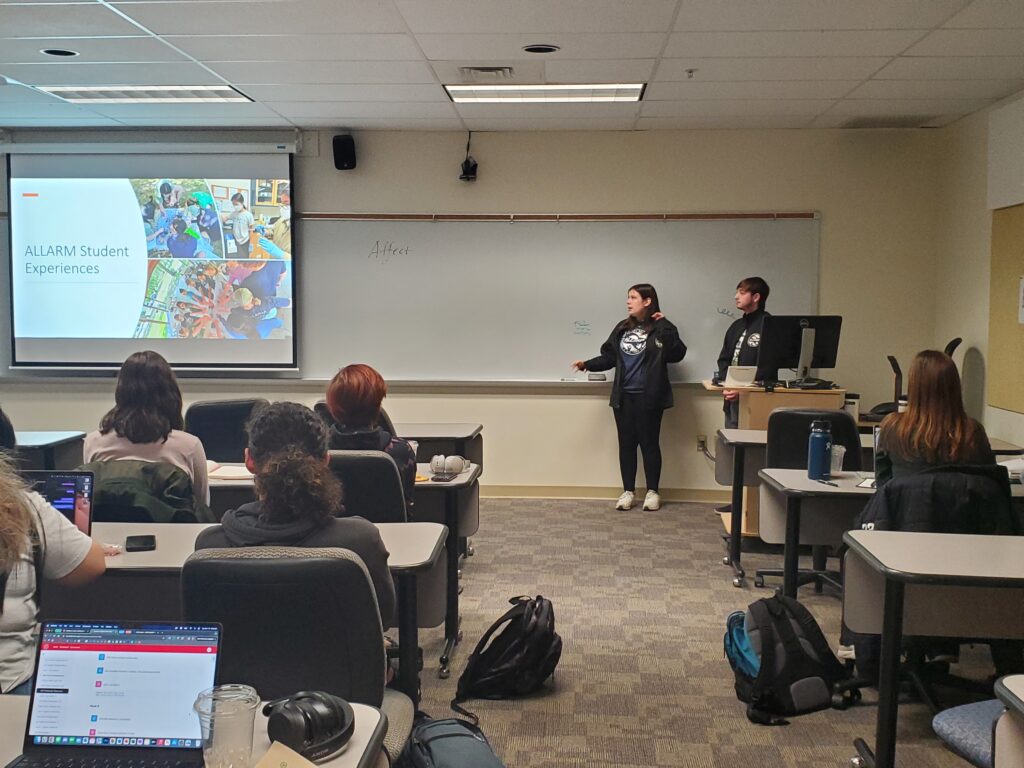On Tuesday, March 19th, we (Max Carfrey ’26 and Emma Spinelli ’25) had the privilege of visiting Professor Benka-Coker’s Environmental Studies 162 class along with ALLARM director, Jules Vastine. The purpose of this class visit was to introduce ALLARM, discuss the Clean Water Act, and speak to the role of communities in collecting scientific data. Towards the end of the presentation, we also had the opportunity to give insight into what it’s like to be an ALLARM watershed coordinator

Emma: Presenting in Professor Benka-Coker’s class was truly a full circle moment for me that I am very grateful for. Not only was he a professor who made me excited to engage more with environmental policy and ground-up work, but it was through an ALLARM class visit that happened during my time in his Environmental Studies 162 course that I first learned about the organization. My contribution to the overall presentation focused on the larger structures in water policy that guide ALLARM’s efforts with a focus on what the Borough of Carlisle and ALLARM have done as a result. My research for the presentation included learning about the different sections of the Clean Water Act that we interact with, how this has influenced Chesapeake Bay Goals resulting from Executive Order 13508, and gave a more local context that allowed students to see responses to the Clean Water Act.
Max: In preparation for the class visit to Professor Benka-Coker’s class, I did a lot of research on influencers of water quality—including geology, land use, climate, and point vs. nonpoint source pollution. Since I did not know a ton of information on geology and land-use, I utilized past videos made by ALLARM to dive into the science behind water quality. For example, for geology, I looked at how limestone affects conductivity and water temperature in creeks with its calcareous nature compared to other creeks that have more of a non-calcareous nature. Similarly, analyzing landscapes that are more developed compared to natural areas, I was able to point out factors such as impermeable surfaces and runoff as influencers to water quality.
One highlight for me during this presentation was taking the research and putting it into context with Mill Creek, a site that two of our volunteers, Lettice Brown and Mark Lentz, monitor. This site is special to me because when I first started working at ALLARM, this was the site that I first looked at. Moreover, I was able to speak to both Lettice and Mark a couple weeks back while I was working on another project, so this presentation felt very memorable to me since I was able to share their story. To know that I have come so far at ALLARM this academic year makes me excited to participate in more events and share the stories that are integral to the community’s work in keeping freshwater bodies healthy and clean.
A favorite memory from this visit was looking around the room at the students we were talking to and seeing some of the passion that they had in their eyes when I was discussing the importance of the work that ALLARM does. It felt like I was making an impact on the people surrounding me and speaking to a class that I was once in with my previous professor there was incredible. From this visit, I learned that water quality can be influenced by many factors but the most important thing is to ensure that freshwater bodies continue to be monitored so that we can flag pollution from human impact.
We also had the opportunity to check in with Michelle Hom ’24, our colleague who taught the other ENST 162 class being taught by Professor Decker. When asked how it went, she said: “Overall, I really enjoyed by class visit! I specifically liked sharing the importance of Stream Team and their role in increasing temporal and spatial data for the Chesapeake Bay region. The class visit was also a full circle moment for me since I took ENST 162 with Professor Decker and applied to work at ALLARM after Jules’ presentation during my freshman year.” It was so interesting to hear that we all had similar pathways into joining ALLARM!
Overall, presenting at Professor Benka-Coker’s class was a full circle moment for both of us since we first heard about ALLARM through it last year. It was a really amazing experience being able to discuss how the CWA and water quality influencers play into the work that we do at ALLARM and in water quality monitoring in general. We can’t wait to see what other opportunities will be presented to us again soon!
